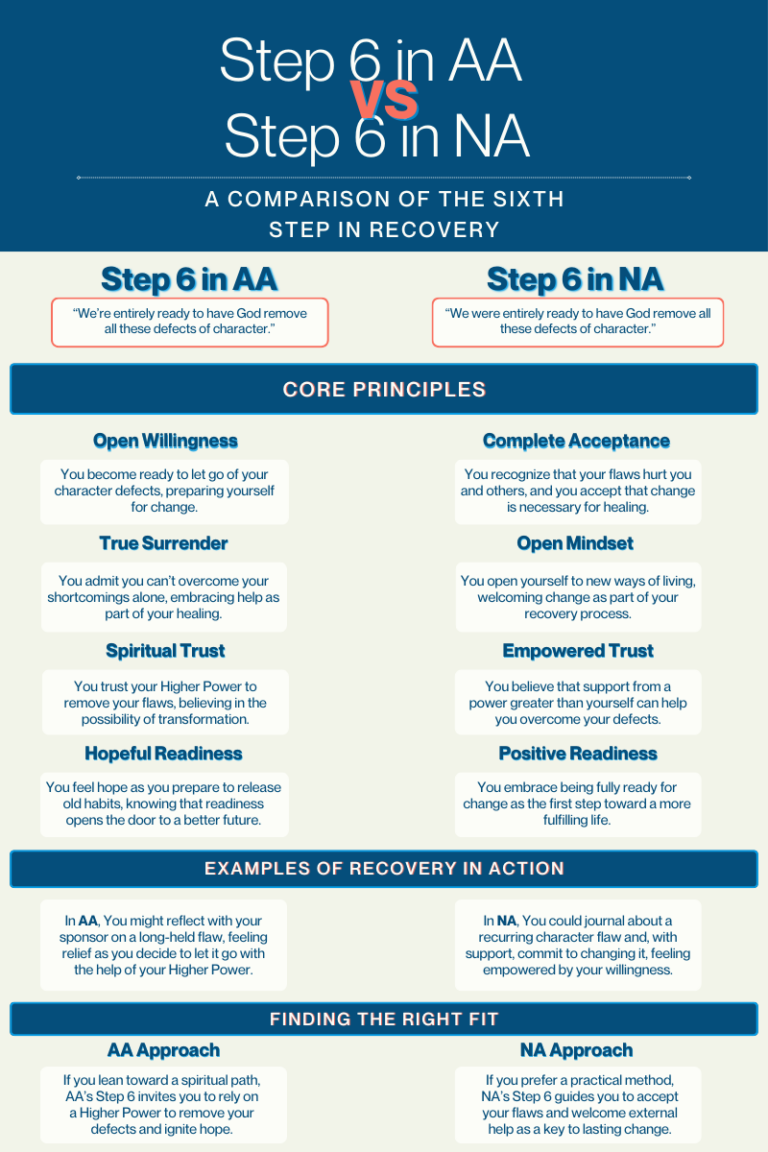Step 6 in AA and NA is where recovery shifts from reflection to action.
After confronting your past in Step 4 & Step 5 this one asks you to embrace willingness—letting go of behaviors that no longer serve you.
It’s not about fixing flaws overnight; it’s about trusting growth, even when change feels uncertain.
Whether you lean on a higher power, your support group, or your resilience, Step 6 in AA and NA bridges self-awareness to transformation.
Here’s how to navigate this step with clarity and compassion.
Start Your Healing Journey Today!
Explore our residential, outpatient, and virtual addiction treatment programs at Cornerstone.

What Is Step 6 in AA and NA?
Step 6 AA states: “Were entirely ready to have God remove all these defects of character.”1
Step 6 in NA states: “We were entirely ready to have God remove all these defects of character.” (mirrors this but emphasizes personal accountability). 2
Both versions of the 12 steps of AA and NA ask you to become willing to release harmful patterns like dishonesty or fear.
This isn’t about erasing flaws instantly—it’s about trusting the process.
Your “higher power” might be a recovery group, a mentor, or the quiet belief that “I deserve peace.”
Step 6 in AA isn’t a finish line; it’s the courage to say, “I’m open to change.”
The AA 12-step program and NA’s approach agree that willingness is the key to growth.
The AA Step 6 Prayer: A Tool for Surrender
The AA Step 6 prayer is a simple yet powerful way to practice surrender: “God, please help me become ready to let go of my shortcomings. I trust you to guide me toward growth.”
This prayer isn’t about religion—it’s about humility.
If “God” doesn’t resonate, replace it with what gives you strength: your group, nature, or the hope of recovery.
The goal is to release control and invite change. In NA, you might focus on actionable commitment: “Help me replace old habits with courage.”
Whether spoken aloud or written, this prayer reminds you, you don’t have to do this alone.3
Watch: A Message from Our Founder on Step 6
Step 6 is about becoming ready—truly ready—to let go of the character defects that no longer serve you. It’s not about perfection, but willingness.
In this short video, Cornerstone Healing Center’s founder and CEO, Estil Wallace, shares reflections on what it means to embrace change from the inside out, and how this step helps pave the way for lasting transformation.
Why Step 6 in AA & NA Is So Important
Step 6 is the bridge between self-awareness and action. Here’s why it’s transformative:
- Old Habits Trap You: Resentment, pride, or fear act as emotional armor—they shield you from vulnerability but lock you in cycles of addiction.
- Letting Go = FREEDOM: Releasing these patterns might feel like losing part of yourself, but it’s how you reclaim your life.
- You Need Willingness, Not Certainty: You don’t need all the answers. Showing up, even when scared, is enough.
- Space for Growth: Releasing what no longer serves you creates room for healthier relationships, self-respect, and peace.
- Progress Starts Small: A single thought—“Maybe I don’t have to stay stuck”—can ignite change.
The 12 steps of AA and NA teach that recovery isn’t about perfection.
It’s about choosing courage over comfort, one brave step at a time.
Quick Tip: Let Go of “All or Nothing” Thinking
Common Struggles With Step 6
Letting go of ingrained habits in Step 6 in AA and NA can feel like losing part of yourself.
You might fear, “Who am I without these traits?” or doubt, “What if I fail?”
Others resist change: “I’ve always been this way.”
The 12 steps of AA and NA acknowledge these struggles but remind you that willingness isn’t about certainty—it’s about showing up.
To move forward:
- Start Small: Choose one trait (like defensiveness) to release—progress, not perfection, is key in the AA 12-step program.
- Talk to Your Sponsor: Their experience with the 12 steps for AA can offer practical advice and hope.
- Reframe Willingness: “I’ll try to pause before reacting today”—small actions build momentum.
- Write a Mantra: “Letting go is how I grow” to anchor your commitment to the 12 steps of AA.
Again, you don’t need all the answers—just a willingness to begin.
How to Work Through Step 6
Start small.
Choose one behavior to release, like blaming others, and reflect on how it has affected your relationships or self-worth.
Use these steps to begin:
- Journal about how this behavior has impacted your life.
- Talk to your sponsor—their experience with the 12 steps for AA and NA can provide insight.
- Pray, meditate, or use the Step 6 prayer: “I’m ready. Help me let go.”
- Lean on your group’s strength if spirituality isn’t your path.
Willingness grows with practice.
The AA and NA 12 steps of recovery aren’t a checklist—they’re a journey.
Celebrate small victories, like recognizing old habits and choosing a healthier response.
AA vs. NA: Small Differences, Same Goal
While both programs share Step 6’s core goal—willingness to change—their approaches differ slightly:
- AA emphasizes surrendering flaws to a higher power through prayer or meditation. For example, the AA Step 6 prayer might be: “God, help me become ready to let go.”
- NA focuses on personal accountability, encouraging actionable steps like journaling or setting daily intentions (“Today, I’ll practice honesty”).
The 12 steps for AA and NA agree that willingness is key.
In AA, the AA Step 6 prayer might involve asking God for strength.
In NA, it’s committing to daily actions aligned with your values.
Neither path is “better”—choose what resonates.
What matters is believing you’re worth the effort.
Check out the comparison graphic below, for an even better understanding:

What Comes After Step 6?
Step 7 follows: “Humbly asked Him to remove our shortcomings.”
After Step 6 in AA, Step 7 is action—seeking support to let go. In the AA 12-step program, this might mean prayer; in NA, accountability exercises with a sponsor.
Both require humility and patience.
Think of Step 6 as gathering courage and Step 7 as taking the leap.
You’re not erasing your past—you’re making space for who you’re becoming.
Frequently Asked Questions
What is Step 6 in AA?
Step 6 in AA is about becoming willing to let go of harmful patterns like dishonesty or fear—not erasing them overnight, but trusting a higher power (like your group or faith) to guide your growth. It’s the bridge between self-awareness and action.
What’s the AA Step 6 prayer?
A common AA Step 6 prayer is: “God, help me release my shortcomings. I’m ready to grow.” Adapt it to your beliefs—replace “God” with “group” or “hope” if needed. The goal is humility, not rigid rules.
How does NA’s Step 6 differ from AA’s?
NA’s Step 6 focuses on personal accountability over spiritual surrender. While AA uses prayer, NA emphasizes actionable steps—like journaling or leaning on your sponsor—to replace old habits. Both paths teach that willingness sparks change.
What if I don’t feel ready for Step 6?
Key Takeaways
- Key Takeaways
- Step 6 AA and NA is about willingness, not immediate change.
- Step 6 helps identify and release harmful behaviors.
- Letting go creates space for growth.
- Progress begins with small acts of openness.
Begin Your Healing Journey at Cornerstone
Step 6 in AA & NA is where courage meets hope—a choice to believe you’re worthy of growth, even when it feels messy.
If you’re struggling with addiction and ready for change, we’re here to help.
At Cornerstone Healing Center, we blend the 12 steps of AA and NA with therapy, group support, and compassion to help you navigate this transition.
Recovery isn’t about erasing the past; it’s about building a future where you’re free to rewrite your story.
Reach out today to learn more about our personalized treatment programs and take your next step toward healing.






